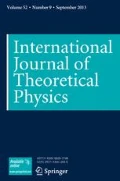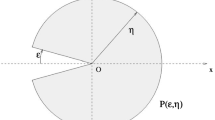Abstract
Three classes of finite-dimensional models of quantum systems exhibiting spectral degeneracies called quantum catastrophes are described in detail. Computer-assisted symbolic manipulation techniques are shown unexpectedly efficient for the purpose.


Similar content being viewed by others
References
Dorey, P., Dunning, C., Tateo, R.: Spectral equivalences, Bethe Ansatz equations, and reality properties in 𝓟𝓣-symmetric quantum mechanics. J. Phys. A: Math. Gen. 34, 5679–5704 (2001)
Bender, C.M.: Making sense of non-hermitian Hamiltonians. Rep. Prog. Phys. 70, 947–1018 (2007)
Dorey, P., Dunning, C., Tateo, R.: The ODE/IM correspondence. J. Phys. A: Math. Theor. 40, R205–R283 (2007)
Mostafazadeh, A.: Pseudo-Hermitian representation of quantum mechanics. Int. J. Geom. Meth. Mod. Phys. 7, 1191–1306 (2010)
Znojil, M.: Three-Hilbert-space formulation of Quantum Mechanics. Symmetry, Integrability and Geometry: Methods and Applications, vol. 5, 001, p. 19 (2009)
Bender, C.M., Boettcher, S.: Real spectra in non-Hermitian Hamiltonians having pt symmetry. Phys. Rev. Lett. 80, 5243–5246 (1998)
Siegl, P., Krejčiřík, D.: On the metric operator for the imaginary cubic oscillator. Phys. Rev. D 86, 121702(R) (2012)
Scholtz, F.G., Geyer, H.B., Hahne, F.J.H.: Quasi-Hermitian operators in quantum mechanics and the variational principle. Ann. Phys. (NY) 213, 74–101 (1992)
Kato, T.: Perturbation theory for linear operators. Spinger, Berlin (1966)
Znojil, M.: Quantum catastrophes: a case study. J. Phys. A: Math. Theor. 45, 444036 (2012)
Znojil, M.: N-site-lattice analogues of V(x) = ix 3. Ann. Phys. (NY) 327, 893–913 (2012)
Jones, H.F.: Interface between Hermitian and non-Hermitian Hamiltonians in a model calculation. Phys. Rev. D 78, 065032 (2008)
Znojil, M.: Scattering theory with localized non-Hermiticities. Phys. Rev. D 78, 025026 (2008)
Krejčiřík, D., Bíla, H., Znojil, M.: Closed formula for the metric in the Hilbert space of a 𝓟𝓣-symmetric model. J. Phys. A: Math. Gen. 39, 10143–10153 (2006)
Znojil, M.: Complete set of inner products for a discrete 𝓟𝓣-symmetric square-well Hamiltonian. J. Math. Phys. 50, 122105 (2009)
Znojil, M., Wu, J.: A generalized family of discrete PT-symmetric square wells. Int. J. Theor. Phys. 52, 2152–2162 (2013)
Znojil, M.: Solvable model of quantum phase transitions and the symbolic-manipulation-based study of its multiply degenerate exceptional points and of their unfolding. Ann. Phys. (NY) 336, 98–111 (2013)
Znojil, M.: Maximal couplings in 𝓟𝓣-symmetric chain-models with the real spectrum of energies. J. Phys. A: Math. Theor. 40, 4863–4875 (2007)
Char, B.W. et al.: Maple V Language Reference Manual. Springer, New York (1993)
Znojil, M.: Symbolic-manipulation constructions of Hilbert-space metrics in quantum mechanics.Lecture Notes in Computer Science 6885, 348–357 (2011)
Znojil, M.: Quantum inner-product metrics via recurrent solution of Dieudonne equation. J. Phys. A: Math. Theor. 45, 085302 (2012)
Znojil, M.: On the role of the normalization factors κ n and of the pseudo-metric P in crypto-Hermitian quantum models. Symmetry, Integrability and Geometry: Methods and Applications. SIGMA 4, 001 (2008)
Heiss, W.D.: The physics of exceptional points. J. Phys. A: Math. Theor. 45, 444016 (2012)
Znojil, M.: Quantum Big Bang without fine-tuning in a toy-model. J. Phys. Conf. Ser. 343, 012136 (2012)
Thom, R.: Structural stability and morphogenesis. An outline of a general theory of models. Benjamin, Reading (1975)
Arnold, V.I.: Catastrophe Theory. Springer-Verlag, Berlin (1992)
Langer, H., Tretter, C.: A Krein space approach to PT symmetry. Czechosl. J. Phys. 70, 1113–1120 (2004)
Krejčiřík, D., Siegl, P., železný, J.: On the similarity of Sturm-Liouville operators with non-Hermitian boundary conditions to self-adjoint and normal operators. Compl. Anal. Oper. Theory 8, 255–281 (2014). arXiv:1108.4946
Hernandez-Coronado, H., Krejčiřík, D., Siegl, P.: Perfect transmission scattering as a 𝓟𝓣-symmetric spectral problem. Phys. Lett. A 375, 2149–2152 (2011)
Ambichl, P., Makris, K.G., Ge, L., Chong, Y.-D., Stone, A.D., Rotter, S.: Breaking of PT symmetry in bounded and unbounded scattering systems. Phys. Rev. X 3(041030), 9 (2013)
Author information
Authors and Affiliations
Corresponding author
Appendices
Appendix A: A Brief Account of the PTQM Formalism
1.1 A.1 Introduction of Sophisticated Hilbert Spaces \(\mathcal {H}^{(S)}\) with Nontrivial Physical Inner Products
In the Bender’s and Boettcher’s PTQM quantum theory one replaces (2) by a less usual but, presumably, “friendlier” Schrödinger equation
where \(|\psi ^{(F)}\rangle \, \in \, \mathcal {H}^{(F)}\,\) and where the Hamiltonian is allowed non-Hermitian, H≠H †. It is only required that H possesses a real and non-degenerate bound-state-type spectrum. The basic mathematical idea of the PTQM theory may be then formulated as a natural rejection of the “first” Hilbert space \(\mathcal {H}^{(F)}\) as “false” and unphysical, i.e., as yielding a manifestly non-unitary evolution of the system in question via (26). Once we want to interpret (26) as fully compatible with any textbook on quantum mechanics, we simply must move to an amended, “second” Hilbert space \(\mathcal {H}^{(S)}\) [8].
The first condition of consistency of such a procedure is that the two Hilbert spaces \(\mathcal {H}^{(F)}\) and \(\mathcal {H}^{(S)}\) only differ from each other by the definition of the respective inner products. With no difference between the ket-vectors themselves, |ψ (S)〉 ≡ |ψ (F)〉 , the change only involves the linear functionals (i.e., the so called bra-vectors). Thus, one simply replaces the common (a.k.a. “Dirac’s”) anti-linear Hermitian-conjugation operation
valid in \(\mathcal {H}^{(F)}\) by its alternative
valid in the “standard” physical Hilbert-space \(\mathcal {H}^{(S)}\) (cf. also [5] for more details). The purpose of the introduction of the latter general formula which contains an optional Hilbert-space metric operator Θ = Θ† > 0 is that an appropriate choice of the metric Θmust make our Hamiltonian H self-adjoint in \(\mathcal {H}^{(S)}\). Mathematically speaking [21] one must merely guarantee the validity of the Dieudonné’s compatibility condition
The key problem of the assignment of a suitable Hermitizing metric Θ to a given non-Hermitian Hamiltonian H is that the Dieudonné’s constraint (29) still leaves the metric Θ = Θ(H) (and, hence, the physical inner product and the physical Hilbert space \(\mathcal {H}^{(S)}\)) non-unique. Fortunately, according to the older review [8] the resolution of the problem is imminent. One merely specifies a K−plet of additional observables \(\mathcal {C}_{j}\), j = 1, 2, …, K with such a count K that the metric (which makes them all self-adjoint) becomes unique.
1.2 A.2 −symmetric Quantum Systems
A hidden reason of the recent success and appeal of the PTQM formalism in applications [2, 3] may be traced back to its trademark use of an additional, heuristically enormously productive assumption
This means that our Hamiltonian operator H is required self-adjoint in another, associated Krein space \(\mathcal {K}\) which is defined as endowed with an indefinite metric (i.e., pseudo-metric) \(\mathcal {P}\) [4, 28]. Relation (30) re-written in its formally equivalent and, among physicists, perceivably more popular representation H = H explains the words “ −symmetry of H”.
The uniqueness of the physical interpretation of −symmetric quantum models is often based on the K = 1 postulate of existence of a single “missing observable” \(\mathcal {C}_{1}\), exhibiting all of the characteristics of a charge (cf. [2, 3] for a virtually exhaustive account of this version of the theory). In our present paper a less widespread strategy of making the metric unique is taken from paper I.
Appendix B: BIM—GPM Correspondence at Large N
In (7) the inner subvector Q|ψ〉 with (N − 4) components {ψ 3, … , ψ N−2} may be interpreted as an exact solution of an incomplete set of the standard discrete free-motion conditions
Whenever this middle-partition vector Q|ψ〉 is given in advance, then, on the contrary, the third line of (7) may be re-read as the definition of component ψ 2 while the (N − 2)nd line defines ψ N−1. At this moment we are left just with the remaining first two rows of our equation,
plus, mutatis mutandis, with the last two rows. In terms of the not yet specified parameter δ ψ 3/2 the first row enables us to define the last ket-vector component ψ 1. Once we eliminate ψ 1 from the second row, we obtain
At the large dimensions N ≫ 1, the latter relation may now be quite naturally re-read as an extension of (31) to k = 2, based on a self-consistency condition
Now one may recall the most natural approximate, large −N identification of the matrix indices j = 1, 2, … , N with the suitable equidistant grid points of a real interval. In the corresponding map j → x j = x 0 + jh, the constant h > 0 is assumed small, h ∼ 1/N.
In the limit of large N, the ket-vector elements ψ j may be then re-read as the values of a wave function ψ(x) at the respective coordinate x = x j . Similarly, relation (33) acquires the simplified meaning of the so called Robin’s boundary condition at x = x 0,
A close connection emerges with the local-interaction model of Ref. [14]. It is worth adding that the latter, manifestly non-Hermitian model found an interesting immediate physical interpretation via an R-matrix description of one-dimensional quantum scattering [30, 31]. These observations may be also read as another encouragement of the study of the multiparametric NNIM generalizations of the one-parametric BIM model (7).
Rights and permissions
About this article
Cite this article
Lévai, G., Růžička, F. & Znojil, M. Three Solvable Matrix Models of a Quantum Catastrophe. Int J Theor Phys 53, 2875–2890 (2014). https://doi.org/10.1007/s10773-014-2085-x
Received:
Accepted:
Published:
Issue Date:
DOI: https://doi.org/10.1007/s10773-014-2085-x



